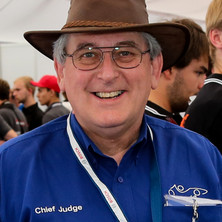I have just returned from Formula Student India, where the importance of re-covering the basics became obvious. We forget the churn of students through Formula Student and often the basics are forgotten when new teams attempt to advance on the designs of previous teams.
The first and most obvious thing seen is that the Newtonian dictum of F=ma is often forgotten. The amount of the force 'F' available to teams is limited by the rules, so if the acceleration 'a' is to be increased, then the only real option is to reduce the mass 'm'.
I regularly repeat 'Pat's three rules of FS design to students'. They are...
1) All other things being equal, the car with the lowest mass will win.
2) All other things being equal, the car with the lowest c/g of the suspended mass will win,
3) All things being equal, the car with the lowest polar moment of inertia in all axes will win.
I ask teams to write a simplified version of these rules in permanent marker in the top left hand corner of the whiteboard in their design office...
1. Reduce the weight.
2. Lower the weight.
3. Centralize the weight.
Then, every design decision to be made must be measured against those three requirements.
A simple example might be, "What battery do we use, lithium or lead/acid"?
Rule 1 shows it must be the lithium option as it is much lighter.
Then, "Where should we mount it"?
The answer, according to Rule 2, is it must be mounted on the floor and Rule 3 states it must be mounted centrally. An ideal position would be just behind the firewall. Not in the nose of the car, ahead of the master cylinders as shown below.

Virtually every car in India was fitted with push-rod or pull-rod suspension operation. Some designs were dreadful with the team clearly not able to visualize the load paths. When asked 'Why?", no team could give a satisfactory answer! By looking at pictures of FS and FSAE cars on Google, they determined all FS cars use such suspension operation, but none questioned why it was so.

I explained that changing the bell-crank geometry, the spring and damping rates could be changed, but all admitted that the only changes they ever made was to spring preload or to damper valve adjustments, thus showing that the complications imposed by actuating rods just added weight and increased the cost and parts count.
When the bell-crank assemblies and associated brackets etc., were subjected to Pat's three rules, they failed on all counts!
When I explained to them that some of the fastest FS cars in the world, ie. GFR and Monash, use direct acting suspension, I was met with blank stares. They had not seen pictures of that on Google!
This is a clear example of 'Monkey see, monkey do', where teams copy design ideas without having a full understanding of the reason for the design feature in the first place. Remember, the first question the Design Judges will ask is "Why"? and if there is no satisfactory answer, then the score awarded will be low. The judges understand there will be a fair amount of Design carryover in most cars, so often the "Why?" question is not just an investigation of knowledge, but also a check on the knowledge transfer within the team. An answer often heard is 'The student who designed that has graduated". Such an answer is the kiss of death to a team's aspirations to make it into the Design Finals.
Another issue identified by the Design Judges in India was the 'Kit car syndrome'. where the team bought in most of the components needed to build a car, including uprights, hubs, steering assembly, differential, bell-cranks, brakes etc, and the assembled them into a car.
The judges understand that a team cannot make all the components used in their car, but they do expect the team to 'Design' rather than 'Assemble' a car around these components. This would entail some 'reverse engineering' of components like uprights so a proper FEA assessment might be made to justify the choice of those components to the judges.

This picture shows a 'Kit car' upright used on a FS car.
A quick perusal of the picture shows the designer clearly did not understand the forces involved.
This car did not clear Technical Inspection, but if it had, I would have expected a failure of the bottom outboard rod end in a very short time.
Cars at FSG are expected to be tested before the event and video evidence submitted. Such testing would have identified this potential problem before the event, giving time for some re-designing and rectification.
Note, neither the top or bottom threaded fasteners are locked as required by the rules.
In closing, it would be improper to end a discussion that included FS India without complimenting the team from K.J.S.C.I. Mumbai on their second consecutive win in the event. We will see this team at FS Germany in the Summer.
Design Error of the Month
We regularly see failures of carbon-fibre suspension members. Usually, this occurs when the threaded insert or clevis pulls out as a result of an adhesive failure.

When the Design Judges ask if the part integrity has been tested, invariably we are shown some test pieces and the associated data. But when we ask if the actual part fitted to the car has been tested, we usually get a blank look!
My suggestion would be to test all these parts, A-arms, Pushrods, Toe-links etc. before fitting them to the car for competition.
Until next time, good luck in your project.

Pat Clarke

